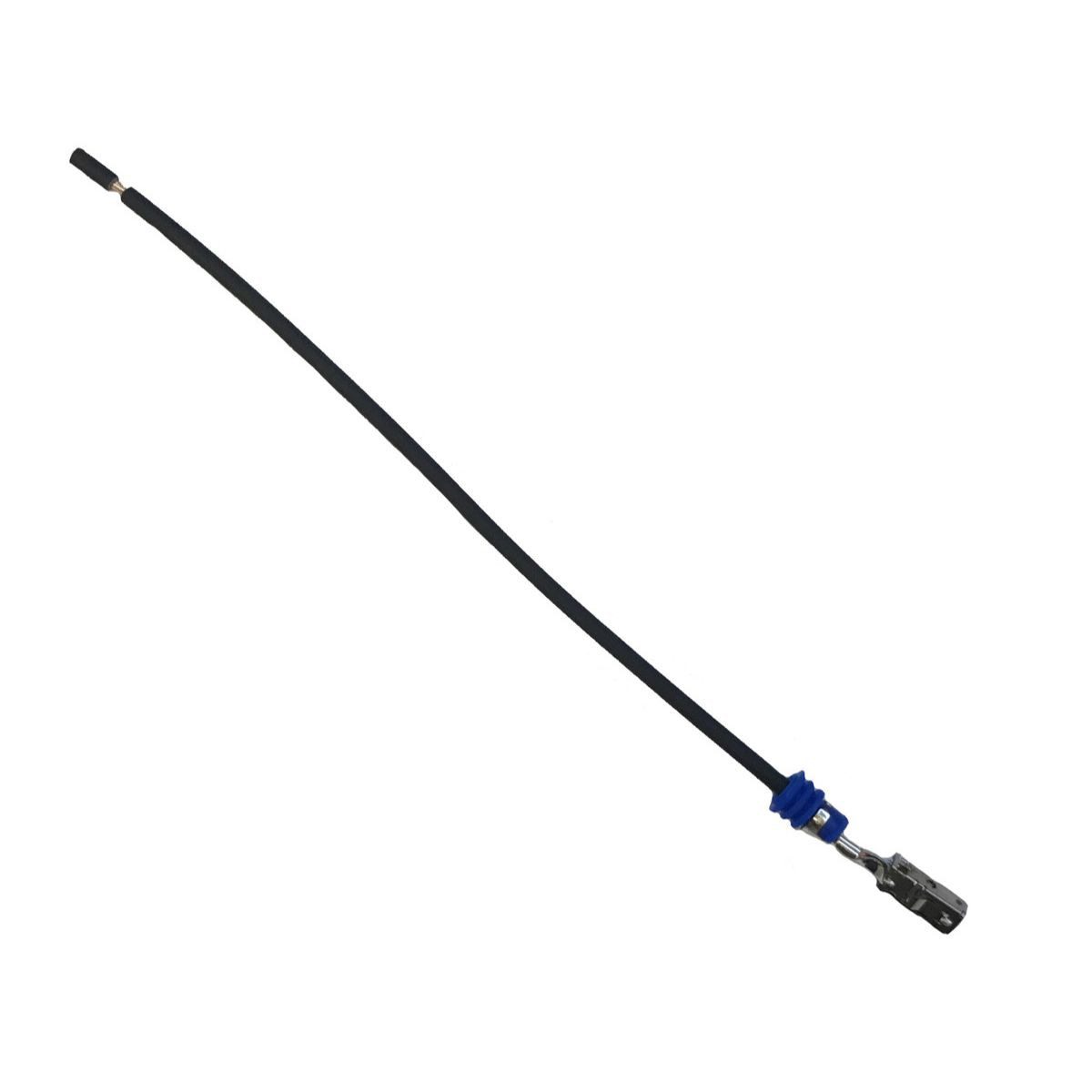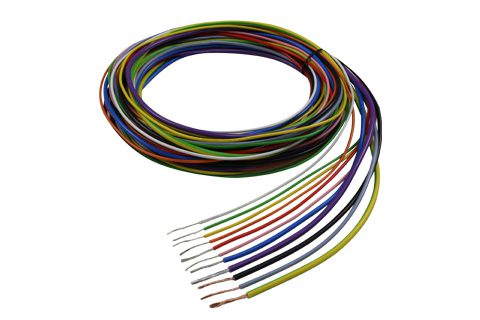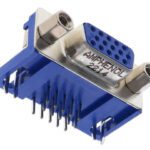What are Lead Wires?
Meet the Connector: Lead Wires
Lead wires are two small lengths of wire extending from the pole of an electrical component, such as a resistor, capacitor, or semiconductor device, used to connect the component to a circuit or another component. They may also be called hook-up wires, appliance wires, or simply leads.
Lead wires predate the use of connectors and date back to the earliest days of the field of electricity. As electronics evolved, the need for reliable connections between electronic components became apparent. The development of various materials for insulation, such as rubber and later synthetic polymers, further facilitated the use of wires for connecting electronic components. As electronics expanded into industries including telecommunications, medical devices, control panels, military equipment, and consumer electronics, the demand for specialized lead wires with specific properties grew.

Chief Enterprises pre-terminated wire lead with terminal and wire seal is made with automated machinery for a perfectly crimped connection.
Lead wire considerations for connectors
The attachment of lead wires to connectors can be accomplished with various techniques and methods to ensure a reliable and secure connection.
Soldering is a widely used method for attaching lead wires to connectors. In this process, the exposed conductors of the lead wires are tinned with solder, and the corresponding terminals or pins on the connector are also tinned. The tinned wire and terminal are then heated and joined together using solder. This method provides a strong electrical and mechanical connection.
Crimping involves using a crimp tool to compress a metal sleeve or ferrule onto the exposed conductor of the lead wire and the corresponding terminal on the connector. This creates a secure connection without the need for soldering. Crimped connections are commonly used in applications where soldering may not be practical or where repeated connections and disconnections are expected.
Insulation Displacement Connection (IDC) connectors have sharp contacts that pierce the insulation of the lead wire to make a connection with the conductor. This method is often used in applications where quick and tool-free connections are desired, such as in certain types of connectors used in telecommunications or data cabling.
Compression or clamp-type connectors are designed to securely hold the lead wire in place through compression or clamping mechanisms. The lead wire is inserted into the connector, and a screw, clamp, or compression mechanism is tightened to create a firm connection.
Twist-on connectors typically have a screw-on cap that secures the twisted wires. In simpler electrical installations, lead wires can be attached to connectors by twisting the conductors together and using twist-on wire connectors.
Cable lugs are used for larger wires or cables. These are metal terminals that can be crimped or soldered onto the ends of lead wires, providing a connection point for attachment to larger connectors or terminals.
The choice of attachment method depends on factors such as the application, the type of connector, the size of the wires, and the desired level of reliability.

BizLink’s hook-up wires are PVC insulated and cold and heat resistant from 60 °C to 105 °C.
Size
Choose lead wires with an appropriate size and gauge for the application. The wire diameter and gauge should match the specifications of the connectors and the electrical requirements of the circuit. Some applications, especially in neurostimulation or implantable devices, may require very small, micro-sized wires. These can have diameters in the range of micrometers (µm) or even smaller. The gauge number is inversely proportional to the diameter, so higher gauge numbers indicate thinner wires. In some cases, lead wires are part of cable assemblies that include multiple conductors within a single cable.
Flexibility and bend radius
Consider the flexibility of lead wires, especially in applications where flexibility is crucial. Determine the minimum bend radius the lead wires can withstand without damage.
Temperature rating
Lead wires should have temperature ratings suitable for the application. Consider operating conditions, including ambient temperature and potential heat generated within the system. In some situations, lead wires act as a heat sink.
Design Notes
Standardization
Lead wires are subject to various standards and regulatory requirements to ensure the safety, effectiveness, and quality of the devices. UL and CSA standards apply. In medical applications, compliance with U.S. FDA regulations, EU CE Marking (Medical Device Directive or Medical Device Regulation), and EU Medical Device Directive (MDD) or the Medical Device Regulation (MDR) may also apply. Lead wires for military/aerospace applications may be subject to relevant wire and cable standards, such as MIL-W-3861 or MIL-N-46026A.

Minnesota Wire makes disposable and reusable (sterilizable) lead wires for medical applications such as wearable electronics and patient monitoring systems.
Sensor applications
When working with lead wires in the context of sensors, specific considerations ensure accurate signal transmission, reliable connections, and the overall effectiveness of the sensor system.
Length and resistance
Keep lead wire length within recommended limits to minimize resistance and signal loss. Long lead wires can introduce resistance, affecting the accuracy of sensor readings, especially in applications where precise measurements are critical.
Signal integrity
Maintain the integrity of the sensor signal by choosing lead wires with appropriate shielding and minimal susceptibility to electromagnetic interference (EMI). Shielded cables can help reduce noise and ensure accurate sensor readings.
Strain relief
Implement proper strain relief techniques to prevent mechanical stress on the lead wire and connector junction. Strain relief can extend the life of the connection and reduce the risk of wire breakage.
Materials
The choice of materials depends on the specific application, the type of sensor or device being connected, and the related durability requirements. Copper is a common conductor material, but in some applications, materials like silver or alloys may be preferred. In medical applications, biocompatible insulation materials may be used around lead wires. The core conductive material is also important. Stainless steel, gold, platinum, or nitinol, a nickel-titanium alloy that exhibits unique shape memory and superelasticity, are corrosion-resistant and can be used as a conductive core in lead wires used in applications that may be exposed to moisture. Temperature rating should also be considered in the context of the application. Some leads may have color-coded insulation.
Sealing
For use with sensors or other components that are exposed to moisture, lead wires and connectors must be adequately waterproofed and sealed to prevent water ingress and protect the electronics.
Cable Management
Proper cable management prevents tangling, twisting, or entanglement of lead wires. This is especially important in applications where sensors are subjected to movement or where multiple sensors are used.
Markets and Applications
Industrial, Medical, Military and Aerospace, Test & Measurement
In medical electronics, lead wires play a crucial role in connecting sensors, electrodes, and devices to monitoring or treatment equipment. Common medical applications include:
- Electrocardiography (ECG/EKG), in which lead wires are used to connect electrodes placed on the patient’s skin to an ECG machine. These electrodes detect the electrical signals generated by the heart, and the lead wires transmit these signals to the monitoring equipment for analysis.
- Electroencephalography (EEG), in which lead wires connect electrodes attached to the scalp to the EEG machine, allowing the recording and analysis of brainwave patterns.
- Electromyography (EMG), in which lead wires connect electrodes to muscles to measure and record the electrical activity produced during muscle contractions. This information helps in diagnosing neuromuscular disorders.
- Patient Monitoring Systems, in which lead wires are used to connect various sensors, such as temperature sensors, pulse oximeters, and blood pressure cuffs, to patient monitoring systems. These systems continuously track vital signs and provide real-time information to healthcare professionals.
- Neurostimulation devices, such as deep brain stimulators or spinal cord stimulators, use lead wires to transmit electrical impulses to specific areas of the nervous system for therapeutic purposes.
- Defibrillators use lead wires to connect the defibrillator pads or paddles to the device. When a shock is administered to the patient’s chest, the lead wires ensure the proper transmission of the electrical energy to the heart.
- Pacemakers use electrical impulses to regulate the heart’s rhythm, and lead wires play a crucial role in transmitting these impulses. Lead wires are used to connect pacemaker electrodes to the heart.
Suppliers
Lead wires are available in many variations from many suppliers, including BizLink, Carlisle Interconnect Technologies, Chief Enterprises, DigiKey, Molex, TE Connectivity, 3M, Belden, Brim Electronics, Leoni AG, McMaster-Carr, Northwire Inc., Southwire Company
Related products
Wire and Cable
Like this article? Check out our other Meet the Connector and Wire and Cable articles, our Medical Market Page, and our 2023 and 2024 Article Archives.
Subscribe to our weekly e-newsletters, follow us on LinkedIn, Twitter, and Facebook, and check out our eBook archives for more applicable, expert-informed connectivity content.
- Where in the World is Amphenol LTW’s Luc Kan? - April 23, 2024
- TE Connectivity’s Sustainability Efforts Pay Off - April 23, 2024
- What is a VGA Connector? - April 23, 2024





